
Everyone involved in the sport of scuba diving knows, for numerous reasons, it is not the kind of sport you do alone. When diving you always dive with a partner, what we divers call our "dive buddy." An obvious reason to never dive alone is safety. Having a dive buddy insures that there is someone there to help you cope with an emergency should one arise. Anne and I are fortunate since we are married and by default dive buddies. I never dive without her and she never dives without me. It just goes unsaid that we always dive together and never alone.
Anne has proven her value as a dive buddy more than once and in more than one way. She's reminded me of little things like forgetting my weight belt or fins just before jumping into the water a hundred times. However, there is one particular way she has proven to be invaluable and indispensable, she is, in effect, my eyes and, sometimes, my mind when we're underwater.
In our family Anne is legendary for her ability to spot the smallest objects at distances no one else could possibly see. It's happened a million times, we'd be riding down the road and she'd tell everyone to look at some hawk in some far off tree. Her eyesight isn't perfect and she needs corrective lenses above and below water, but with those lenses, she can see things a long time before anyone else can. This works perfectly for our underwater adventures. I'm the photographer and she's the spotter.

Anne
Repeatedly on our dives Anne spots interesting coral formations or tropical marine life long before I do. Spotting them she will get my attention and direct me to whatever it is that she spots. How many times, I remember, going in the direction she's pointed and looking for the subject she's pointed to and still not being able to see it. We use sign language underwater and she signals what it is I am suppose to be looking for. Even knowing what I'm looking for it is sometimes difficult to see the object.
Our most recent dives on Grand Cayman proved to be no different than hundreds of others. Anne spotted and I chased the objects down and photographed them. These dives alone she spotted a nice lobster, a buried stingray, countless Queen and French Angels, a resting Porcupine fish, several barracudas and tarpon. We've worked out a pretty good team effort.
Anne usually hovers above me somewhat spotting for something interesting. Once spotted she directs me to whatever she's spotted and I chase it down with my camera. While I'm taking pictures she's watching me and keeping an eye open for the next challenge. By the time I finish taking whatever pictures I am going to take she's usually spotted the next object for me. Sit back and enjoy some of things that Anne spotted for me to photograph on this last trip to Cayman.
 |
|||||||||||||||||||||||
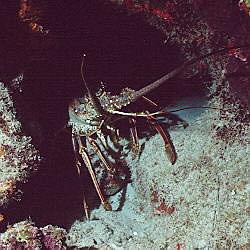 |
|||||||||||||||||||||||
| We were on our second dive at Turtle Reef when Anne gave me the lobster sign, two-fingers held in a "V", wiggling. He was a good size lobster, enough for dinner for two for sure, but we followed the diver's golden rule ... "take nothing and leave only bubbles." As I moved in to get closer and closer, he, of course, took refuge further back into his hiding place. We tried to coax him out but wasn't successful, so these are the only two pictures we got of him. | |||||||||||||||||||||||
| After a few minutes spent trying to coax him out we continued with our dive when Anne again got my attention. This time she was signing that she'd seen a stingray and pointed to the lower portion of a coral formation. I looked and looked and looked but still didn't see him. I moved in closer confident that I was approaching the right place and, all of a | |||||||||||||||||||||||
| sudden, there he was. The difficulty in spotting him was because he was quite small and half buried in the sand. How Anne spotted him I'll never known. | |||||||||||||||||||||||
 |
|||||||||||||||||||||||
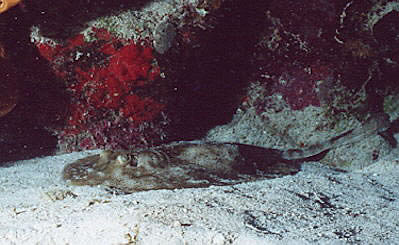 |
|||||||||||||||||||||||
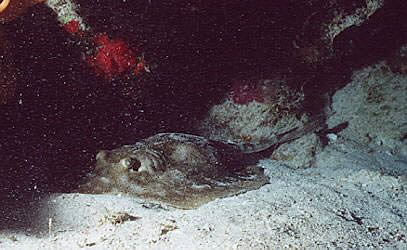 |
The key to underwater photography is ... "if you can't get close, don't bother taking the picture." I managed to get very close to this little fellow without scaring him off, but the closer I got the worse the picture was. Why? Because of having to bring the flash into a more direct lighting position. The flash, aimed directly at the Stingray, caused all the little particles in the water to reflect the light back toward the lens creating the little white spots in the picture. Having had our fun with the Stingray we moved on in search of another exciting animal to photograph. We weren't disappointed at all when, within seconds, Anne spotted a beautiful Queen Angel. Queen Angels are one of my favorite tropical fish to photograph. Not only do they offer the logistic challenges of trying to get close enough at a good enough angle, but their intricate pattern of blue and gold colors offers a technical challenge to capture the colors perfectly. When all is said and done of every one hundred pictures you take of a Queen Angel you're lucky if you've got one really good and several OK photographs. |
||||||||||||||||||||||
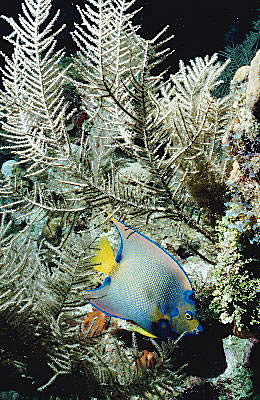 |
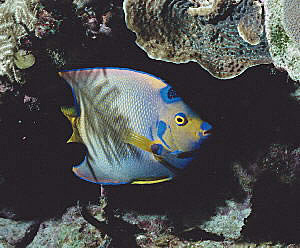 |
 |
|||||||||||||||||||||
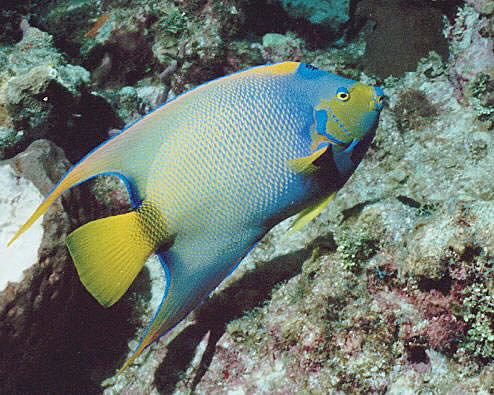 |
|||||||||||||||||||||||
|
The Queen Angel, as you can readily see, is a majestic and most beautiful animal. I'll never tire of taking her picture and continue hoping that, one day, I will get what I consider to be a perfect picture of Her Majesty. Over the years I've taken a number of good pictures of her, but I'm still waiting for that one special picture. Who knows, perhaps I'll get that picture on my next dive. I keep hoping. Having spotted a beautiful lobster, a hidden Stingray, and her Majesty, the Queen, our air was running low and it was time to return to the surface. On the way back we had another opportunity to get a special picture. |
|||||||||||||||||||||||
| Another favorite tropical fish to photograph is the White-spotted Filefish. While this fish is common and considerably easier to photograph than a Queen Angel, there is one special picture that I have been trying to get for years to no avail. | 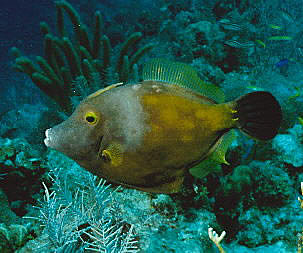 |
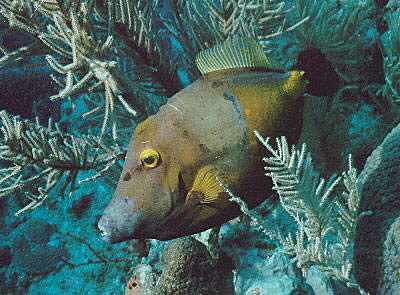 |
|||||||||||||||||||||
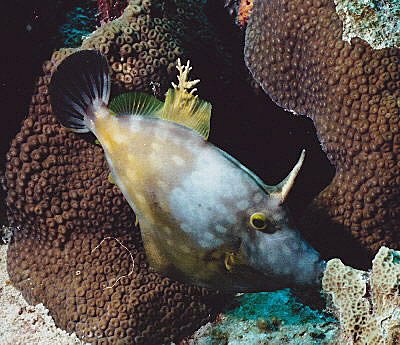 |
Just above the Filefish's eyes there is a horn (for lack of a better word to describe it) that, most of the time, is kept flat against the back. The two pictures above show the Filefish with its horn laid flat against its back. I have hundreds of pictures of Filefish like this. Perfect composition, beautiful color and the flattened horn. If you're lucky, and I mean really lucky, the Filefish might extend the horn to its upward position, and if your ready when that happens you get a perfect picture. Unfortunately they only raise the horn occasionally and, when they do, you're either to far off or not ready to take the picture. This last trip I almost got that perfect picture (see the photo at left). You notice I said "almost" and not "did." The picture, in my opinion, is almost perfect, but its nose is hidden behind a piece of coral. A good picture, but not the perfect shot I'd hoped for. |
||||||||||||||||||||||
|
|||||||||||||||||||||||